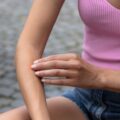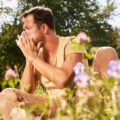Pollen allergy

Spring is approaching rapidly, bringing joy for many. Nature is awakening and flowers are blooming all around us. But it’s not good news for everyone, as the pollen count is starting to rise, and with it the suffering caused by allergies, especially hay fever.
The SARS-2 CoV coronavirus has the whole country firmly in its grip, and now people with respiratory issues have to add the pollen count into the mix. The prospects aren’t great for allergy sufferers.
The most important pollens in Germany are hazel, alder, pine, ash, birch, acacia, sweet grass, rye, mugwort and ragweed. The problem is that the flowering times of pollen species can shift from year to year. Depending on the weather and temperature profile, the pollen count may begin to rise earlier or later in the year. Warm, dry weather favours a high pollen count.
In urban areas, the pollen count is highest in the evening, while in the country it is highest in the morning. Sounds strange, but it’s true. So if you live in the city, you should air your house in the morning, whereas in the country you should wait until the evening. In pollen allergy sufferers, the urge to cough is usually worst at night and early in the morning when the pollen count is extremely high. The urge to cough is usually accompanied by difficulty breathing and/or sneezing. The whole thing can go on for several hours.
The first symptoms for allergy sufferers usually appear in late February and early March when alder and hazelnut trees begin to bloom, followed by poplar and ash trees. Birch pollen is added to the mix at the end of March and grass pollen in mid-May, which can continue into early autumn.
In summer, a range of herb pollens further increase the pollen count. Herb pollens include summer herbs such as mugwort, ribwort and nettles. These pollen molecules are very small and are spread over long distances by the wind, meaning that they often come into contact with the mucous membranes of allergy sufferers. From spring onwards, allergy sufferers really need to have a pollen calendar.
Grass allergies
The most common allergies are grass pollen allergies. Grasses are early bloomers and one of the most common allergy triggers. The extensive plant family contains around 8000 species.
The strongest allergic reactions can be traced back to tall grasses in grazing meadows. These include timothy grass (phleum pratense), false oatgrass (arrhenatherum elatius) and cat grass (dactylis glomerata). Allergy sufferers should generally avoid meadows and pastures.
The symptoms of grass pollen allergy include a rash with small welts, itchy and reddened skin, swollen eyes, a runny nose, swollen and reddened mucous membranes, sneezing and shortness of breath. Grasses that contribute to grass pollen include sweet grass, buffalo grass, cat grass, meadow bluegrass, cereals, timothy grass and lolium grass.
“Asthma weed” is on the rise
The parietaria plant, sometimes known as “asthma weed” or pellitory-of-the-wall, is a dangerous year-round bloomer that has spread across Germany. This plant’s pollen contains very strong allergens. It is expected that over 80 percent of allergy sufferers will react to this pollen. The plant migrated to Germany from Mediterranean countries. The problem is, it can grow anywhereand can bloom all year round.
Allergy to birch pollen
Birch pollen gives rise to a common and very aggressive form of pollen allergy. Like ash and oak pollen, birch pollen levels are highest from March to the end of May, and can even last into July. Birch pollen is one of the strongest, most aggressive tree pollen allergens that we know of, and it occurs in huge volumes.
A single birch tree can produce almost 100 million pollen molecules. The fine birch pollen powder penetrates everywhere and covers surfaces, clothing, hair and the whole body. Scientists assume that up to 25 percent of all pollen allergy sufferers react to birch pollen. The symptoms of birch pollen allergy are extremely unpleasant.
They include swollen eyelids and red, itchy, watery eyes. This can severely affect allergy sufferers’ quality of life and significantly restrict their activities. Further symptoms include persistent sneezing, swelling of the nasal mucous membranes and a constantly blocked or runny nose.
Sufferers of birch pollen allergy often complain of a general feeling of illness, fatigue and headaches. If left untreated, birch pollen allergy can affect the respiratory tract and may even lead to asthma in the long term.
A short history of pollen and allergies
It is estimated that pollen has been around for 300 million years. It is essential for the pollination of over half of the earth’s plants.
Spread by the wind, pollen is transferred from one flower to another. As a result, it gets into every nook and cranny. For many people, the pollen carried by the wind is associated with allergies.
Allergies are pathological reactions of the immune system triggered by external substances which enter the body through our breathing, gastrointestinal tract, skin, mucous membranes and/or blood vessels. The term allergy was coined in 1906 by Clemens von Pirquet, a Viennese paediatrician. Today he is considered to be the founder of clinical allergy theory.
But as early as 1565, the Italian surgeon Leonardo Botallo discovered that some people suffered from sneezing fits and narrowing of the airways when they had been near roses in bloom. In 1819, the London-based doctor John Bostock described a seasonal nasal disease. In 1870, Charles Blackley discovered that grass pollen was the triggering cause of “hay fever“.
Today it is estimated that more than 30 percent of people are affected by allergies, and the trend is rising, although there has been no satisfactory explanation for the increase in recent decades. What we do know is that sniffing, sneezing and itchy eyes are on the rise.
Excessive hygiene measures?
We found the following on Wikipedia: The hygiene hypothesis – some researchers attribute the observed increase in allergic diseases in Western industrialised countries to the so-called “dirt and jungle hypothesis”. The hypothesis is based on insufficient activation of the immune system (“insufficient demand”) – especially in childhood and early adolescence – due to excessive hygiene measures.
It suggests that coming into contact with certain bacteria is important, especially in the first few months of life, in order to steer the immune system, which leans towards TH2 responses during pregnancy, back in the direction of TH1 responses, which are less associated with allergic reactions. One prominent study on the subject is the ALEX study. However, it has not yet been proven whether this is a sufficient explanation.
Researchers have also discovered: “Children of women who had contact with animals, cereals and/or hay during pregnancy are less likely to develop allergic respiratory and skin diseases later in life. For optimal protection, however, constant contact with farm animals and/or cereals is necessary”. Clear evidence of an increased allergy risk is only present in children if one or both of their parents are allergic.
The first step is recognising whether you have allergy symptoms. These include a frequently blocked nose in the morning, a runny nose, the urge to sneeze, burning or watery eyes, frequent tingling, coughing and itching in the throat, and an itchy nose and/or eyes. You might also suffer from difficulty breathing, or swelling and reddening of the mucous membranes.
When it comes to combating allergy symptoms, we are spoilt for choice: eye drops, nasal sprays or tablets? For drugs containing antihistamines, this depends not only on your symptoms, but also on individual preferences. Some allergy sufferers swear by eye drops or nasal sprays. Others find them too bothersome, as they have to be used several times a day; they prefer to take a tablet.
What can sufferers of pollen allergies do?
As far as treating allergies with drugs is concerned, naturally the doctors are in charge.Well, we’re not doctors, but Ökotest.de shares some very good advice in this article. Twenty-two allergy drugs were assessed. Eye drops, nasal sprays or tablets? For drugs containing antihistamines, this depends not only on your symptoms, but also on individual preferences.
Are there other ways to protect yourself from pollen? You could wear an FFP2 protective mask when outdoors, for example – we’re already familiar with them and some of us have already got used to wearing one.
If you fear that you may be allergic to pollen, you should have your symptoms diagnosed by a doctor.
In whatever form it arrives, you should be able to enjoy the coming spring.




